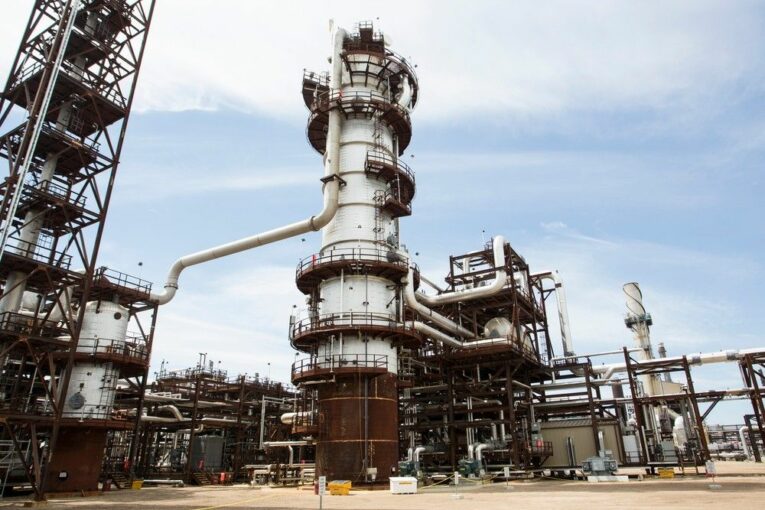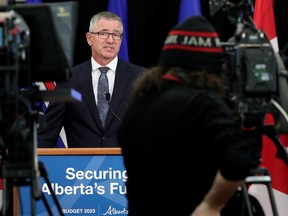
The provincial budget didn’t include any shiny new incentive packages for a massive carbon capture and storage project planned in Alberta’s oilsands.
But the door isn’t shut on providing help, says Alberta’s finance minister.
Leaders in Canada’s oilpatch warned this week that the country is falling behind the U.S. Inflation Reduction Act (IRA) in offering financial assistance to kickstart an array of low-carbon developments, including carbon capture projects.
On Thursday, Calgary-based Parkland Corp. ditched a $600-million renewable diesel development in British Columbia, citing, in part, the role of U.S. incentives in advantaging American producers.
While pressure is mounting on federal and provincial governments to increase aid for decarbonization ventures, Finance Minister Travis Toews called on Ottawa to boost its own assistance to carbon capture developments while Alberta examines its existing help.
“We’re obviously very supportive of carbon capture and storage,” Toews said in an interview.
“We are not closing the door. In fact, in the budget, we have noted that we’re committed to working with the industry to understand what more may be required.”

The federal and provincial governments have lobbed a series of verbal grenades at each other in the past year over support for carbon capture, utilization and storage (CCUS) projects proposed in Alberta.
To date, most remain in the planning phases.
It includes a $16.5-billion development pitched by the Pathways Alliance, a group of six large oilsands producers.
The companies, including Canadian Natural Resources and Suncor Energy, plan to build a 400-kilometre CO2 pipeline to initially connect 14 oilsands facilities to an underground storage hub near Cold Lake.
Canadian Natural Resources president Tim McKay told analysts on Thursday there are “no showstoppers” to date with the project. However, Canada is trailing the U.S. in the race to attract such investment.
“With the Inflation Reduction Act, they moved ahead of Canada. And part of it is, you have to have a competitive financial structure here in Canada that competes against other jurisdictions.”
In an interview, McKay said there was “nothing” financially in the provincial budget to help the Pathways project, but he’s encouraged the province is “looking at the broader picture.”
“Hopefully, there’s more encouragement coming from the federal government,” he said.
His comments echo remarks from Enbridge CEO Greg Ebel, who told reporters this week the U.S. has put a lot of carrots on the table to attract investment.
In last spring’s federal budget, the Trudeau government established a new investment tax credit that will cover up to 50 per cent of CCUS project spending.
In August, the Biden administration increased an existing U.S. tax credit for carbon capture initiatives to $85 for each tonne of stored CO2, up from $50, eclipsing Canada’s offer.
The lobbying is increasing on both Alberta and Ottawa to get off the sidelines, and all eyes will be on the upcoming federal budget.
In January, Prime Minister Justin Trudeau called out Alberta to step up with more incentives for carbon capture.
Last month, Premier Danielle Smith wrote a letter to the prime minister, saying the province was willing to adopt a co-ordinated approach to an incentive program with Ottawa, expanding the Alberta Petrochemicals Incentive Program to include CCUS initiatives.
Recommended from Editorial
-

Chamber of Commerce disappointed by lack of downtown funding in 2023 budget
-

Oil well cleanup program listed as ‘key objective’ in budget
-

Varcoe: Canadian energy spending accelerates as demand — and the transition — intensifies
-

Varcoe: Strong oil price gives Alberta financial firepower for cutting debt and spending
During an event this week, Calgary Chamber of Commerce CEO Deborah Yedlin compared the federal-provincial debate to “a game of chicken.”
At what point will the squabbling end?
Parkland said it will not move ahead at this time with a plan announced last May to build a stand-alone renewable diesel complex at its refinery in Burnaby.
On Friday, CEO Bob Espey told analysts that several factors affected the project’s competitiveness, including rising costs, a lack of market certainty around emerging fuels and the IRA.
“I would say the biggest change in our business in the renewable space has been the IRA,” he said.
In the provincial budget, the Alberta Technology Innovation and Emissions Reduction (TIER) fund, which collects revenue from large industrial emitters, is allocating $77 million in the new year to future carbon capture projects.
Funding of $246 million over three years for the province’s Carbon Capture and Storage Initiative is also being earmarked to support developments, including the existing Alberta Carbon Trunk Line and Quest project.
Toews noted the government is working to understand the value of the “implicit support” of offsets available through the province’s royalty system to oilsands operators for investments made into CCUS projects.
Former premier Jason Kenney frequently called it a “multibillion-dollar contribution.
“That work is important because I believe it’s going to demonstrate that Albertans have a big stake and are making a significant contribution,” Toews added.
“We’re certainly prepared, after the work is done, to look at filling any gaps.”
Providing incentives to the oilpatch during a time of soaring profits will face opposition.
Greenpeace Canada’s Keith Stewart noted five of the largest Canadian-based oilsands companies notched more than $34 billion in profits last year.
Since 2009, Canadian oilsands production has more than doubled and emissions per barrel have dropped by 21 per cent, but total emissions increased by 29 megatonnes, according to a report last year by S&P Commodity Insights.
Carbon capture projects are a “top tier technology” for oilsands producers to reach net-zero emissions by 2050, said Kevin Birn, an S&P vice-president.
“We are seeing incentives for CCUS in almost every corner of the world. So, the concept isn’t unique to Canada,” Birn said.
“Decarbonization is going to take projects and it’s going to take money. It’s going to take investors that are willing to put money in and use it to generate revenue.”
Chris Varcoe is a Calgary Herald columnist.
You can read more of the news on source
